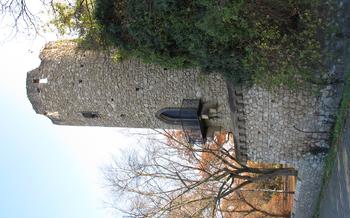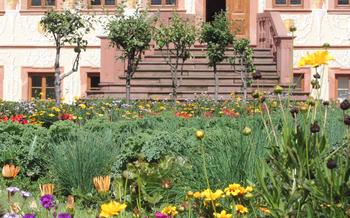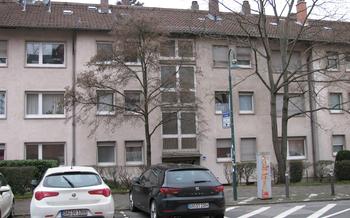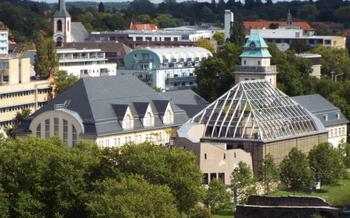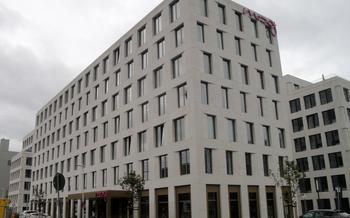
Art Nouveau Bathing Temple
- A Journey Through Time
- Mathildenhöhe
- Wedding Tower
- Russian Chapel
- Exhibition Halls
- Jugendstilbad
- Jugendstil Museum
- Landestheater Darmstadt: A Stage for Art and History
- Darmstadt Artists' Colony: A Haven for Creativity
- Insider Tip: Hidden Gems
A Journey Through Time
Darmstadt, a city in the heart of Germany, is a treasure trove of Art Nouveau architecture. The Mathildenhöhe colony, founded in 1899 by Grand Duke Ernst Ludwig, was a hotbed of creativity and innovation, attracting artists and architects from all over Europe. Inspired by the ideals of the Arts and Crafts movement, they sought to create a Gesamtkunstwerk, a total work of art, that would encompass all aspects of life. The result was a unique ensemble of buildings, parks, and sculptures that showcased the latest trends in Art Nouveau design. Today, Mathildenhöhe is a UNESCO World Heritage Site and a must-see for anyone interested in this fascinating period in art history.
Theoretical
The Mathildenhöhe colony was a melting pot of ideas and influences. Artists and architects from different countries and backgrounds came together to create something truly unique. The result was a style that was both modern and traditional, embracing new technologies while still respecting the past. The buildings on Mathildenhöhe are characterized by their flowing lines, intricate ornamentation, and use of natural materials. They are a testament to the skill and craftsmanship of the artists and artisans who created them.
Practical
The best way to experience Mathildenhöhe is to take a leisurely stroll through the colony. Start at the Ernst Ludwig House, the former home of the Grand Duke, and admire its beautiful architecture. Then, wander through the park, stopping to admire the sculptures and fountains. Be sure to visit the Hochzeitsturm, a 50-meter-high tower that offers stunning views of the city. The Russian Chapel is another must-see, with its colorful onion domes and intricate mosaics.
Anecdotes
Many famous artists and architects worked on Mathildenhöhe, including Joseph Maria Olbrich, Peter Behrens, and Hans Christiansen. Olbrich was the chief architect of the colony and designed many of its most iconic buildings, including the Ernst Ludwig House and the Hochzeitsturm. Behrens was a pioneer of modern architecture and designed the AEG Turbine Factory, one of the first industrial buildings to be built in the Art Nouveau style. Christiansen was a sculptor and designed many of the sculptures that adorn Mathildenhöhe.
Insider Tip
If you want to discover hidden Art Nouveau gems, take a walk along the Jugendstil Route, a self-guided walking tour of Art Nouveau landmarks in Darmstadt. The route takes you past some of the city's most beautiful Art Nouveau buildings, including the Otto Beck House, the Prinz-Georg-Palais, and the Landestheater Darmstadt.
Mathildenhöhe
Mathildenhöhe, a hilltop colony on the outskirts of Darmstadt, stands as a testament to the city's rich artistic heritage. Founded in 1899 by Grand Duke Ernst Ludwig, Mathildenhöhe was conceived as an experimental artists' colony, bringing together architects, artists, and craftsmen to create a Gesamtkunstwerk, or total work of art, that encompassed architecture, painting, sculpture, and landscape design.
At the heart of Mathildenhöhe lies the Hochzeitsturm, or Wedding Tower, a striking Art Nouveau tower designed by Joseph Maria Olbrich. This iconic landmark, with its slender silhouette and intricate ornamentation, has become a symbol of Darmstadt and the Mathildenhöhe colony. Surrounding the tower, a collection of Art Nouveau buildings, including the Ernst Ludwig House, the Exhibition Halls, and the Russian Chapel, showcase the diversity and creativity of the artists who worked in Darmstadt.
Mathildenhöhe is not just a collection of buildings but also a living testament to the ideals of the Art Nouveau movement. The colony's emphasis on collaboration, experimentation, and the integration of art into everyday life continues to inspire artists and designers to this day. Whether you're an architecture enthusiast, an art lover, or simply someone who appreciates beauty, a visit to Mathildenhöhe is an unforgettable experience.
Insider Tip: Join a guided tour of Mathildenhöhe to learn more about the history and architecture of the colony. Tours are available in English and German and can be booked in advance or on the spot.
Wedding Tower
The Wedding Tower (Hochzeitsturm) is a striking example of Art Nouveau architecture and a prominent landmark in Darmstadt. Designed by Josef Maria Olbrich, the tower was built between 1905 and 1908 as part of the Mathildenhöhe colony. It served as a water tower and a lookout tower, offering panoramic views of the city and the surrounding countryside.
Theoretical
The tower's design is characterized by its slender, graceful form and intricate ornamentation. Olbrich incorporated elements of Gothic and Islamic architecture, creating a unique and visually captivating structure. The tower is adorned with colorful mosaics, wrought ironwork, and sculptures, all of which contribute to its overall aesthetic appeal.
Practical
The Wedding Tower is open to the public, and visitors can climb the 103 steps to the viewing platform for breathtaking views of Darmstadt and the Odenwald region. Guided tours of the tower are available, providing insights into its history, architecture, and symbolism.
Anecdotes
One of the most famous legends associated with the Wedding Tower is the story of the "White Lady." According to the legend, a beautiful young woman named Maria was engaged to be married to a wealthy merchant. However, on the eve of their wedding, Maria's fiancé was killed in a duel. Maria was so heartbroken that she threw herself from the tower, and her ghost is said to haunt the tower to this day.
Insider Tip
For a truly memorable experience, visit the Wedding Tower at sunset. The golden light of the setting sun casts a warm glow on the tower, creating a magical and unforgettable sight.
Russian Chapel
The Russian Chapel, also known as the Chapel of St. Mary Magdalene, is a unique architectural gem nestled within the Mathildenhöhe colony. Constructed between 1897 and 1899, the chapel was a gift from Tsar Nicholas II of Russia to his sister, Grand Duchess Elizabeth Feodorovna, who lived in Darmstadt with her husband, Grand Duke Ernst Ludwig.
Theoretical: The Russian Chapel is a splendid example of the fusion of Art Nouveau and Russian Orthodox architectural traditions. Designed by the Russian architect Leon Benois, the chapel features a striking combination of Byzantine and Gothic elements. Its onion-shaped domes, intricate mosaics, and colorful stained-glass windows create a captivating visual spectacle.
Practical: The Russian Chapel is open to the public for visits and religious services. Visitors can admire its stunning interior, which includes a richly decorated iconostasis, a magnificent chandelier, and a collection of religious artifacts. Guided tours are available to provide insights into the history and significance of the chapel.
Anecdotes: The Russian Chapel has a poignant history interweaved with the lives of the Russian royal family. Grand Duchess Elizabeth Feodorovna, who played a pivotal role in the establishment of the chapel, was deeply devoted to her Orthodox faith. She often attended services in the chapel and found solace within its sacred walls.
Insider Tip: To fully appreciate the beauty of the Russian Chapel, plan your visit to coincide with one of the regular religious services. The melodious chanting of the choir and the scent of incense create a deeply immersive and spiritual experience.
Exhibition Halls
The exhibition halls on Mathildenhöhe are a testament to the colony's commitment to promoting and showcasing Art Nouveau and contemporary art. The halls, designed by renowned architects such as Joseph Maria Olbrich and Peter Behrens, are themselves works of art, featuring intricate ornamentation and innovative design.
Over the years, the exhibition halls have hosted a wide range of exhibitions, from solo shows by prominent artists to thematic group exhibitions exploring various aspects of Art Nouveau and modern art. Visitors can expect to see a diverse array of works, including paintings, sculptures, furniture, ceramics, and textiles.
One of the most popular exhibitions is the permanent collection of the Darmstadt Artists' Colony, which features works by some of the most influential artists associated with the movement, such as Peter Behrens, Hans Christiansen, and Ludwig Habich. The collection provides a comprehensive overview of the colony's artistic output and its contribution to the development of Art Nouveau.
In addition to the permanent collection, the exhibition halls also host temporary exhibitions, which showcase the works of contemporary artists and explore current trends in art and design. These exhibitions offer visitors the opportunity to experience the latest developments in the art world and to engage with the work of emerging and established artists.
Insider Tip: Check out the gift shop for unique souvenirs and art-inspired products. You can find a wide range of items, from postcards and prints to jewelry and home décor, all inspired by the Art Nouveau movement.
Jugendstilbad
The Jugendstilbad, also known as the Art Nouveau Bathing Temple, is a historical swimming pool complex in Darmstadt, Germany. Built between 1907 and 1909 by the architect Albin Müller, it is considered a masterpiece of Art Nouveau architecture and a symbol of the city's cultural heritage.
The Jugendstilbad is a testament to the innovative spirit of the early 20th century. Its striking features include a domed skylight that floods the pool area with natural light, ornate tilework and stained glass windows depicting scenes of water and nature, and elegant bronze sculptures that adorn the pool's edge. The building's exterior is equally impressive, with its curved lines, floral motifs, and colorful glazed bricks.
Originally intended as a public bathhouse for the working class, the Jugendstilbad quickly became a popular destination for people from all walks of life. It offered a variety of pools, including a large swimming pool, a wading pool for children, and a therapeutic pool with mineral water. The complex also featured a sauna, a Turkish bath, and a massage parlor.
In the 1970s, the Jugendstilbad was closed due to safety concerns. After years of neglect, it was meticulously restored and reopened to the public in 200Today, the Jugendstilbad is a fully functioning swimming pool complex that offers a unique and immersive experience for visitors.
Insider Tip: Take advantage of the massage and sauna services offered at the Jugendstilbad to complete your Art Nouveau bathing experience.
Jugendstil Museum
The Jugendstil Museum in Darmstadt is a treasure trove of Art Nouveau artifacts and artworks, offering a comprehensive overview of this influential artistic movement. The museum's collection includes furniture, glass, ceramics, metalwork, jewelry, paintings, and sculptures, all created during the Art Nouveau period.
Practical Information The Jugendstil Museum is located at Mathildenhöhe 9 in Darmstadt. It is open from Tuesday to Sunday from 10 am to 5 pm. Admission is €6 for adults, €4 for students and seniors, and free for children under 1
Anecdotes One of the most fascinating stories associated with the Jugendstil Museum is the tale of how it came to be founded. In the early 20th century, a group of Darmstadt citizens, including the Grand Duke Ernst Ludwig, began collecting Art Nouveau objects with the intention of creating a museum dedicated to the movement. The museum was finally opened in 1908, and it has been a popular destination for art lovers ever since.
Insider Tip To get the most out of your visit to the Jugendstil Museum, join a guided tour. The tours are led by knowledgeable docents who can provide insights into the history of Art Nouveau and the significance of the exhibits. Tours are available in German and English, and they are free of charge.
Landestheater Darmstadt: A Stage for Art and History
The Landestheater Darmstadt is not merely a theater venue; it is a testament to the city's rich cultural heritage and architectural prowess. Built between 1819 and 1820, this neoclassical masterpiece was designed by the renowned architect Georg Moller. Its grand facade, adorned with intricate carvings and sculptures, hints at the theatrical wonders that await within.
Over the years, the Landestheater Darmstadt has hosted a myriad of acclaimed performances, from classical dramas to contemporary productions. Its stage has been graced by legendary actors and actresses, including Eleonora Duse, Gustaf Gründgens, and Jürgen Prochnow. The theater's reputation for artistic excellence has transcended borders, attracting audiences from far and wide.
In addition to its impressive performances, the Landestheater Darmstadt is also a architectural gem. The auditorium, with its horseshoe-shaped design and opulent decorations, is a sight to behold. The ceiling, adorned with a breathtaking fresco by the artist Ludwig Lindenschmit the Younger, depicts scenes from Greek mythology, adding a touch of grandeur to the space.
Practical Information:
-
Opening Hours: The Landestheater Darmstadt is open for performances throughout the year. Check the theater's website for the current schedule and ticket information.
-
Admission Prices: Ticket prices vary depending on the performance and seating category. Advance booking is recommended to avoid disappointment.
-
Insider Tip: Take advantage of the theater's guided tours to learn more about its history, architecture, and behind-the-scenes operations.
Darmstadt Artists' Colony: A Haven for Creativity
The Darmstadt Artists' Colony, founded in 1899 by Grand Duke Ernst Ludwig, was a vibrant community of artists, architects, and intellectuals who sought to create a new and modern form of art. Inspired by the ideals of the Arts and Crafts movement, the colony's members believed in the importance of collaboration and the integration of art into everyday life.
One of the colony's most influential figures was the architect Joseph Maria Olbrich, who designed many of the buildings in the Mathildenhöhe colony, including the Ernst Ludwig House and the Hochzeitsturm. Olbrich's work is characterized by its flowing lines, geometric patterns, and use of natural materials, which embody the principles of Art Nouveau.
Other notable members of the colony included the artists Peter Behrens, Hans Christiansen, and Ludwig Habich, who created a wide range of works, including paintings, sculptures, furniture, and decorative objects. The colony's members also founded the School of Applied Arts, which trained a new generation of artists and craftsmen in the principles of Art Nouveau.
The Darmstadt Artists' Colony played a pivotal role in the development of Art Nouveau in Germany and beyond. Its members' innovative and experimental work helped to define the movement and set a new standard for artistic expression. Today, the colony's legacy lives on in the many Art Nouveau buildings and artifacts that can be found throughout Darmstadt, making it a treasure trove for anyone interested in this fascinating period of art history.
Insider Tip: Join a guided tour of the Mathildenhöhe colony to learn more about the history and architecture of this unique artistic community.
Insider Tip: Hidden Gems
Beyond the well-known landmarks, Darmstadt hides a treasure trove of lesser-known Art Nouveau gems waiting to be discovered. Venture off the beaten track and explore the city's hidden corners to uncover these architectural wonders. Look for Art Nouveau details in unexpected places, such as door handles, street lamps, and even manhole covers. Visit the Jugendstil Route website or download the app to find a comprehensive list of hidden Art Nouveau treasures in Darmstadt. Ask locals for recommendations on their favorite hidden gems, as they may know about places that are not listed in guidebooks. Discovering these hidden gems is like going on a treasure hunt, and the reward is the thrill of finding something truly unique and special.
